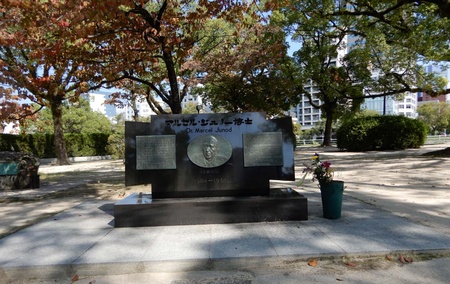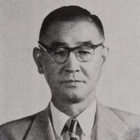Witnessing the devastation wrought by the atomic bomb on the city of Hiroshima and the people there, and losing his younger brother and sister in the bombing, was the starting point for Kato Shinichi's later dedication to the peace movement.
In his diary, which I introduced last time, about his rushing around Hiroshima on the day of the bombing, Kato wrote the following about the deaths of his younger brother and sister.
His younger brother Shozo (24 years old at the time) died three days after the atomic bomb, and his younger sister Fumie (22 years old at the time) died one month later, saying, "Brother, I have avenged my father." However, compared to the countless victims whose bodies remained unidentified, dividing the center of Hiroshima into north and south, with the Navy in the south and the Army in the north collecting corpses in the lowlands, piling them up and burning them with oil (to prevent the stench and infestation of flies due to the extreme heat), and clearing them away from the four days after the bombing, it was at least a relief that they were able to have a simple funeral amongst close relatives.
At the Peace Memorial Hall for the Victims
No further details were given about the two men's exposure to the atomic bomb, but Kato's nephew, Junji Yoshida, told me about the circumstances under which they died. What information is available is registered at the Hiroshima National Peace Memorial Hall for the Atomic Bomb Victims in Hiroshima Peace Memorial Park.
Here, the names and photographs of those who died are registered in order to commemorate those who died in the atomic bombing and to convey the fact that so many people died as a result of the bombing.
On the second basement floor of the memorial hall, the names and portraits of those who died are displayed. You can also search for and call up each person. When I searched for "Shozo Kato" and "Fumie Kato," I found photos of the two young men.
Shozo, with his shaved head and round glasses, had an intelligent look and was wearing a suit and tie. He was 23 years old at the time of the bombing and worked for the Hiroshima Prefectural Agricultural Association. The bombing occurred in Tokaichi-cho, Hiroshima City (now Tokaichi-cho 1-chome, Naka-ku, Hiroshima City), a few hundred meters from the hypocenter. In the evening after the bombing, he took a boat from the bank of Higashihara, Ota River, to Yoshida-san's house in Tosaka, Higashi-ku, but he suffered burns to his face, neck and both hands and died the following day, the 9th.
Fumie was wearing a sailor uniform, smiling slightly and looking lively. She was 20 years old at the time of the bombing, and was working for the Hiroshima Prefectural Food Agency in Hatchobori, Hiroshima (now Naka Ward, Hiroshima). In the evening after the bombing, she traveled by truck to Kabe in the suburbs and came to Yoshida's house on the 16th. On the 18th, she went to Hirara, where Kato lived, and started working on the 20th. However, her hair began falling out at the end of August, and she passed away on September 5th.
It is not clear how Kato, who had previously lived in America, took his sister's words of hatred for America, "Brother, please take revenge," but it is not difficult to imagine that, at the very least, he ultimately acted with the idea that "war was his enemy."
Chugoku Shimbun to resume publication
Having lost family members, Kato himself was exposed to radiation on the day of the bombing as he ran around the city, including near the hypocenter. 22 years later, in 1967, Kato applied for an atomic bomb survivor's health booklet. He was in the shadows at the time of the bombing, but developed symptoms of fever and diarrhea six months after the bombing. However, he returned to work immediately after the bombing and seems to have been active with colleagues who, like Kato, had escaped the disaster.
The Chugoku Shimbun's headquarters was completely burned down in the atomic bombing, the rotary press was also burned, and telephone and telegraph services were cut off, making it impossible to publish the newspaper. They had no choice but to ask the Osaka and Western headquarters of the Asahi Shimbun and the Mainichi Shimbun to deliver a "substitute paper" through the military's radio, which was the only means of communication they had, and printed "Asahi Shimbun" and "Mainichi Shimbun" in smaller letters underneath the title "Chugoku Shimbun," and began publishing the paper on August 9th, three days after the bombing.
Newspapers reported on the dropping of the atomic bomb on Hiroshima on the 8th, but were unable to write "atomic bomb." It was not until the Chugoku Shimbun (an alternative newspaper) on the 16th, when the Imperial Rescript on the End of the War was published, that Hiroshima reported the word "atomic bomb" for the first time.
Immediately after the bombing, reporters and cameramen began to record the disaster, and, without paper or ink, they relayed information to citizens by word of mouth. In order to print the newspaper themselves, they managed to use a printing press that had been evacuated to Nukubina Village (Higashi Ward) on the outskirts of Hiroshima City before the bombing, and published the first self-printed paper since the war on September 3rd.
The front page of this article reported that the surrender document between the Allied powers and Japan had been confirmed on the previous day (the 2nd) aboard the American battleship Missouri in Tokyo Bay. The document was signed by General Douglas MacArthur on the Allied side and by Foreign Minister Shigemitsu Mamoru and others on the Japanese side.
As an interpreter and guide for Dr. Junod
On the day of the self-publishing, American war correspondents from the New York Times, Associated Press, and other media, along with a U.S. military public relations officer and a second-generation Japanese-American interpreter, entered the bomb site and walked around the hypocenter area to see the devastation. Afterwards, they met with the head of the Special Higher Police Division of the Prefectural Police Headquarters and the reporters.
Five days later, on September 8, an investigation team led by Brigadier General Thomas Farrell, the American commander who had commanded the dropping of the atomic bomb, arrived in Hiroshima. Dr. Marcel Junod, Chief Representative of the Red Cross in Japan, accompanied the investigation team. As mentioned in the sixth installment of this series, Kato Shinichi acted as Dr. Junod's interpreter and guide, and was asked by the prefecture to ride in the jeep with him.
The paper dated the 10th quotes the doctor as saying about the atomic bomb, "We must prevent such a thing from ever happening again if possible," which was likely translated by Kato.
According to his nephew Yoshida later, Kato's English had a typical Japanese accent and was by no means fluent.
The Chugoku Shimbun, which had finally become self-publishing and able to disseminate information on the atomic bombing of Hiroshima, was hit by another trial. On September 17, only 40 days after the atomic bombing, the Makurazaki Typhoon struck Hiroshima, and the strong winds rendered the rotary press in Nukunamura unusable. For the citizens of Hiroshima and Okinawa Prefecture, the damage was even worse than that caused by the atomic bombing, with 2,012 people killed, mainly along the coast of the prefecture.
The Chugoku Shimbun decided to repair the burned headquarters and resume operations. There were concerns about residual radiation, but after consulting with experts, they were told that it was "safe," and so they moved forward with the work of returning to the headquarters. Then, on November 5th, about three months after the bombing, the newspaper began self-publishing from the burned-out headquarters.
Prior to this relaunch, the paper underwent organizational reforms and personnel changes, with Kato Shinichi becoming head of the political department.
(Titles omitted)
*References: "1945 Atomic Bomb and the Chugoku Shimbun" and "The 80-Year History of the Chugoku Shimbun" (both published by the Chugoku Shimbun Company)
© 2021 Ryusuke Kawai







